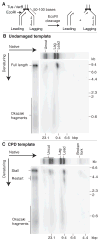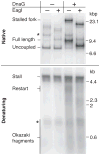The Escherichia coli replisome is inherently DNA damage tolerant
- PMID: 21998391
- PMCID: PMC3593629
- DOI: 10.1126/science.1209111
The Escherichia coli replisome is inherently DNA damage tolerant
Abstract
The Escherichia coli DNA replication machinery must frequently overcome template lesions under normal growth conditions. Yet, the outcome of a collision between the replisome and a leading-strand template lesion remains poorly understood. Here, we demonstrate that a single, site-specific, cyclobutane pyrimidine dimer leading-strand template lesion provides only a transient block to fork progression in vitro. The replisome remains stably associated with the fork after collision with the lesion. Leading-strand synthesis is then reinitiated downstream of the damage in a reaction that is dependent on the primase, DnaG, but independent of any of the known replication-restart proteins. These observations reveal that the replisome can tolerate leading-strand template lesions without dissociating by synthesizing the leading strand discontinuously.
Figures




Similar articles
-
Replisome-mediated translesion synthesis by a cellular replicase.J Biol Chem. 2017 Aug 18;292(33):13833-13842. doi: 10.1074/jbc.M117.800441. Epub 2017 Jun 22. J Biol Chem. 2017. PMID: 28642369 Free PMC article.
-
Dynamics of leading-strand lesion skipping by the replisome.Mol Cell. 2013 Dec 26;52(6):855-65. doi: 10.1016/j.molcel.2013.10.020. Epub 2013 Nov 21. Mol Cell. 2013. PMID: 24268579 Free PMC article.
-
Replication fork reactivation downstream of a blocked nascent leading strand.Nature. 2006 Feb 2;439(7076):557-62. doi: 10.1038/nature04329. Nature. 2006. PMID: 16452972
-
Replisome dynamics and use of DNA trombone loops to bypass replication blocks.Mol Biosyst. 2008 Nov;4(11):1075-84. doi: 10.1039/b811097b. Epub 2008 Sep 18. Mol Biosyst. 2008. PMID: 18931783 Free PMC article. Review.
-
The E. coli DNA Replication Fork.Enzymes. 2016;39:31-88. doi: 10.1016/bs.enz.2016.04.001. Epub 2016 May 13. Enzymes. 2016. PMID: 27241927 Review.
Cited by
-
Cellular characterization of the primosome and rep helicase in processing and restoration of replication following arrest by UV-induced DNA damage in Escherichia coli.J Bacteriol. 2012 Aug;194(15):3977-86. doi: 10.1128/JB.00290-12. Epub 2012 May 25. J Bacteriol. 2012. PMID: 22636770 Free PMC article.
-
A gatekeeping function of the replicative polymerase controls pathway choice in the resolution of lesion-stalled replisomes.Proc Natl Acad Sci U S A. 2019 Dec 17;116(51):25591-25601. doi: 10.1073/pnas.1914485116. Epub 2019 Dec 3. Proc Natl Acad Sci U S A. 2019. PMID: 31796591 Free PMC article.
-
The SOS system: A complex and tightly regulated response to DNA damage.Environ Mol Mutagen. 2019 May;60(4):368-384. doi: 10.1002/em.22267. Epub 2019 Jan 7. Environ Mol Mutagen. 2019. PMID: 30447030 Free PMC article. Review.
-
DNA Helicase-SSB Interactions Critical to the Regression and Restart of Stalled DNA Replication forks in Escherichia coli.Genes (Basel). 2020 Apr 26;11(5):471. doi: 10.3390/genes11050471. Genes (Basel). 2020. PMID: 32357475 Free PMC article. Review.
-
Generation and Repair of Postreplication Gaps in Escherichia coli.Microbiol Mol Biol Rev. 2023 Jun 28;87(2):e0007822. doi: 10.1128/mmbr.00078-22. Epub 2023 May 22. Microbiol Mol Biol Rev. 2023. PMID: 37212693 Free PMC article. Review.
References
Publication types
MeSH terms
Substances
Grants and funding
LinkOut - more resources
Full Text Sources
Other Literature Sources

